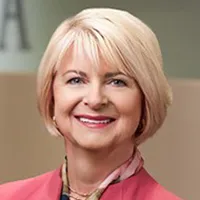Why a crisis makes finance-clinical collaboration more important



From left to right: Pam Cipriano, dean of UVA Nursing School; Robyn Begley, CEO of AONL; Todd Nelson, director of partner relationships and chief partner executive, HFMA.
Finance and clinical leaders need to improve their collaboration to improve results for their patients and organizations. But the benefits of creating more positive relationships are even more important during a crisis, like the COVID-19 pandemic.
The benefits of leaders moving from traditional adversarial roles to tighter collaboration can help them find solutions to new, complex problems that might not be clear to either acting in isolation, said industry leaders during “The Business of Caring: Increasing Value Through Outcomes-Based Staffing,” a June 26 session of the HFMA 2020 Digital Annual Conference.
Pam Cipriano, dean of the UVA Nursing School, recalled a relationship with a CFO who she was able to approach to try to find solutions for complex problems faced by the nursing staff she led.
“And I could always count on that CFO partner to come up with something I hadn’t thought about,” Cipriano said. “That’s when you feel like collaboration is worth it.”
She was joined by Robyn Begley, DNP, RN, NEA-BC, CEO of the American Organization for Nursing Leadership (AONL), and Todd Nelson, FHFMA, director of partner relationships and chief partnership executive for HFMA. Together, they discussed applying “The Business of Caring: Promoting Optimal Allocation of Nursing Resources,” an early 2020 report produced by HFMA, AONL and the American Nurses Association.
Improved relationships between those leaders can spread an attitude of collaboration through their staffs to further collaboration throughout the organization, Begley said.
“It’s really helpful for the partners to be explicitly partners and do things like have lunch together or meet when it’s not budget season, and to continue the relationship,” Begley said.
Initial steps
Key steps to try to improve the sometimes-fraught relationships between financial and clinical leaders that they highlighted, included:
- Involving all stakeholders, including clinical, operations and finance
- Ensuring transparency
- Developing the key relationships
- Starting small — not with new, big projects
- Celebrating successes over a period of time
- Using key metrics for good business decisions
- Looking at challenges — including old challenges — with new eyes
“And sometimes, as we’ve seen during the pandemic, it’s [about finding] old solutions to new problems, not just new solutions to old problems,” Nelson said.
However, hospital leaders need to be patient because improved financial-clinical relationships are like any other human connections, which take time to build and strengthen.
“If the only time that you are spending with each other is during a budget crisis or a pandemic, if you haven’t frankly, built a relationship, can you be thrown together and as leaders come together quickly? Absolutely,” Nelson said. “But collaborative relationships happen over time.”
Changing the conversation
The session illustrated how moving to a collaborative mindset would affect specific conversations the leaders can have when meeting with the CEO.
For instance, in a hypothetical conversation, CFO “Sam” pressed his CNO on why they requested more FTEs “than we can afford.”
The CNO responds that the requested number of nurses are needed to keep patients safe, to report quality measures and to maintain patient satisfaction scores.
In contrast, a collaborative relationship will allow “those discussions and those debates that are important for a positive outcome,” Nelson said.
That may produce post-relationship conversations in which the CFO can tell the CEO “after reviewing volume projections and acuity changes, we agreed to increase resources in a few areas and decrease them in others.”
A little bit scary
Cipriano said that such new ways to approach colleagues with very different professional focuses “could be a little bit scary.”
“It would be easy to point fingers if things didn’t work out well,” Cipriano said. “This model says, ‘We’re all in it together.’”
Coming together can extend to the terminology used, such as “ratio.”
“That can be considered a four-letter word for some nurses, when we think about how that is sometimes linked to defining staffing patterns and the resources that go with it,” Cipriano said.
That can be addressed through a better understanding of the key terms the collaboration will use and on which they will focus their performance.
Another way to move the conversation beyond its traditional format is through the development of joint goals and principles for finance and nursing, Begley said.
“Safety, for example, would be one of those shared principles,” Begley said.
Interprofessional collaboration between nursing and finance will require the CFO and CNO providing an example to their staff that such cooperation is expected, she said.
“Just eating lunch together in the lunch room, where other people could see you, and you were having a normal conversation that wasn’t part of budget meeting, or a meeting between the meeting or a pre-meeting before the meeting,” Nelson said. “That helps to bridge some of the difficult discussions that happen, and other people saw you meeting.”





